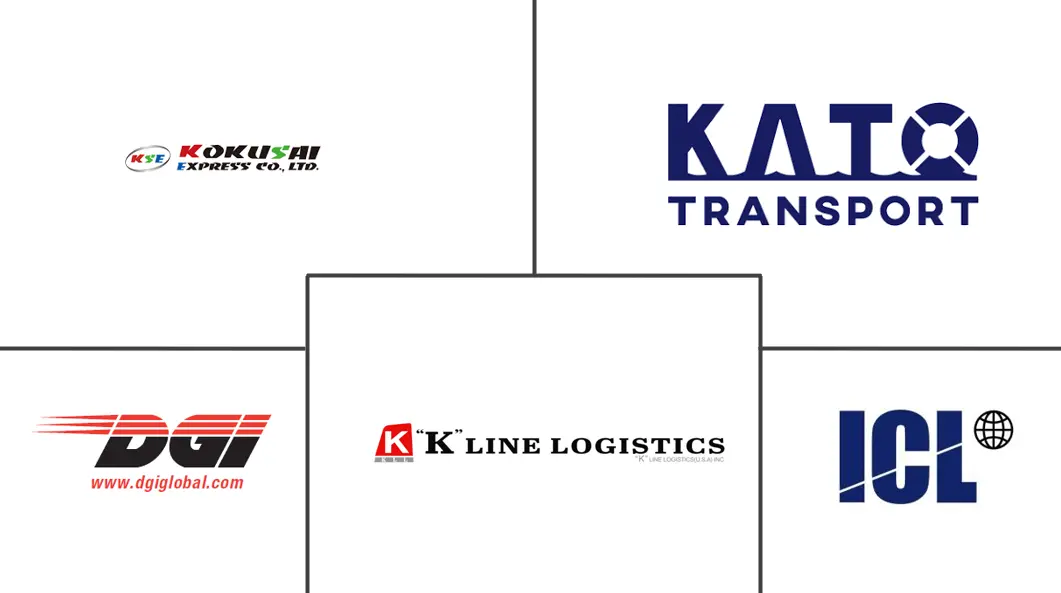Market Size of Japan Dangerous Goods Logistics Industry

| Study Period | 2020 - 2029 |
| Base Year For Estimation | 2023 |
| Market Size (2024) | USD 12.96 Billion |
| Market Size (2029) | USD 16.86 Billion |
| CAGR (2024 - 2029) | 4.71 % |
| Market Concentration | Medium |
Major Players
*Disclaimer: Major Players sorted in no particular order |
Japan Dangerous Goods Logistics Market Analysis
The Japan Dangerous Goods Logistics Market size is estimated at USD 12.96 billion in 2024, and is expected to reach USD 16.86 billion by 2029, growing at a CAGR of greater than 4.71% during the forecast period (2024-2029).
The market growth is driven by factors such as increasing demand for dangerous goods in various industries, stricter regulations for transportation and handling, and the rise of e-commerce. The major types of dangerous goods transported in Japan include chemicals, explosives, flammable liquids, and radioactive materials.
Companies are investing in technology and partnerships to address challenges like regulations and talent shortages. For instance, Mitsubishi Heavy Industries launched a smart container solution that allows the real-time monitoring of temperature and pressure for sensitive, dangerous goods.
In January 2024, the Ministry of Land, Infrastructure, Transport and Tourism (MLIT) announced revisions to the "Law on the Control of Explosives" to strengthen regulations for explosives used in construction and demolition. This could impact logistics companies transporting these materials.
In November 2023, Yamato Transport, a major logistics company, partnered with Yusen Logistics to offer specialized transportation services for lithium-ion batteries, a growing segment in the dangerous goods market. Also, in October 2023, Nippon Express, another major player, announced opening a new logistics facility in Osaka dedicated to handling dangerous goods and showcasing the industry.
Japan Dangerous Goods Logistics Industry Segmentation
Dangerous goods logistics is the transportation of hazardous substances by air, sea, or road. Dangerous goods (DG) are substances that pose a risk to health, safety, property, or the environment when transported. They can be categorized as flammable, explosive, radioactive, bio-hazardous, or allergenic.
The Japanese dangerous goods logistics market is segmented by services (transportation, warehousing & distribution, and value-added services) and destination (domestic and international). The report offers market sizes and forecasts in terms of value (USD) for all the above segments.
| By Service | |
| Transportation | |
| Warehousing and Distribution | |
| Value-added Services |
| By Destination | |
| Domestic | |
| International |
Japan Dangerous Goods Logistics Market Size Summary
The Japan Dangerous Goods Logistics Market is poised for significant growth over the forecast period, driven by increasing demand across various industries, stringent regulations, and the burgeoning e-commerce sector. The market encompasses the transportation of hazardous materials such as chemicals, explosives, flammable liquids, and radioactive substances. Companies are leveraging technological advancements and strategic partnerships to navigate challenges like regulatory compliance and workforce shortages. Notable developments include Mitsubishi Heavy Industries' introduction of a smart container solution for real-time monitoring of sensitive goods, and collaborations between major logistics players like Yamato Transport and Yusen Logistics to enhance transportation services for lithium-ion batteries. Regulatory updates, such as the Ministry of Land, Infrastructure, Transport and Tourism's revisions to explosives regulations, are also shaping the logistics landscape.
The e-commerce boom in Japan, characterized by high internet penetration and a robust network infrastructure, is a key driver of the dangerous goods logistics market. While most dangerous goods are not widely available online due to safety regulations, certain categories like electronics and cosmetics are increasingly sold through e-commerce platforms. The market's growth is further supported by advancements in logistics technology, including automated warehouses and temperature-controlled facilities, which are essential for safely handling sensitive materials. Major logistics companies are adopting modern technologies such as warehousing management systems and automation to enhance efficiency and productivity. The market remains fragmented, with both global and regional players like Kokusai Express, Nippon Express, and Yusen Logistics playing pivotal roles in its development.
Japan Dangerous Goods Logistics Market Size - Table of Contents
-
1. MARKET INSIGHTS
-
1.1 Current Market Scenario
-
1.2 Industry Value Chain Analysis
-
1.3 Government Regulations and Initiatives
-
1.4 Brief on Dangerous Goods Classes
-
1.5 Technology Snapshot
-
1.6 Impact of COVID-19 on the Market
-
-
2. MARKET SEGMENTATION
-
2.1 By Service
-
2.1.1 Transportation
-
2.1.2 Warehousing and Distribution
-
2.1.3 Value-added Services
-
-
2.2 By Destination
-
2.2.1 Domestic
-
2.2.2 International
-
-
Japan Dangerous Goods Logistics Market Size FAQs
How big is the Japan Dangerous Goods Logistics Market?
The Japan Dangerous Goods Logistics Market size is expected to reach USD 12.96 billion in 2024 and grow at a CAGR of greater than 4.71% to reach USD 16.86 billion by 2029.
What is the current Japan Dangerous Goods Logistics Market size?
In 2024, the Japan Dangerous Goods Logistics Market size is expected to reach USD 12.96 billion.

